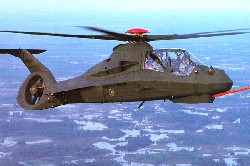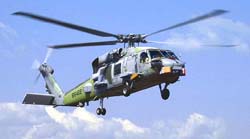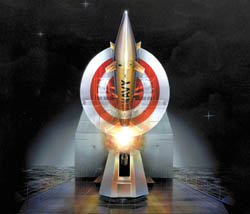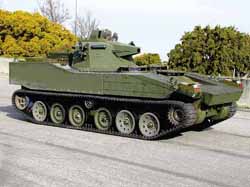Daily News
by Gail Helmer
[ Send Us News | Archives ]
Destroyer Command Gold
Ubi Soft has announced that Destroyer Command, its highly anticipated World War II naval combat simulation, has gone gold. The title is expected to ship to retail shelves in two weeks. Destroyer Command is a 3D naval combat simulation that gives you command of a WWII era destroyer in the US Navy in either the Atlantic or Pacific Theaters. You can advance to command a division of destroyers, participating in a variety of naval actions against Axis forces. Destroyer Command is a complete naval combat experience offering interaction with enemies on land, sea and in the air as you stalk U-boats, swat Kamikaze planes, escort convoys, blast enemy ships in surface actions and pound the beaches in support of infantry landings.
"One of the most unique features of Destroyer Command is the ability to play against owners of the WWII German U-Boat title, Silent Hunter II, via Internet or LAN," said Carl C. Norman, executive producer for Ubi Soft Entertainment. "This is a first in computer gaming, allowing players of two different products to compete against each other on the same virtual battlefield, further enhancing the Destroyer Command experience and fully immersing the player in the game."
World Wide Web War
CDV Software Entertainment UK has today released its latest title - an online mini-game designed to promote the forthcoming UK retail release of Combat Mission. Located at www.minicombat.com, the turn-based strategy game allows players to challenge their mates anywhere in the world to a spot of mini combat. A range of different maps and scenarios are available over a number of different terrains - and each requires a different approach if victory is to be achieved. The number of maps available is set to grow over the coming weeks. An online ranking system tracks worldwide player stats, with monthly prizes offered to the best-performing players.
Sub Command Patch v1.05
A new patch for Sub Command is now available, updating the submarine simulation by Sonalysts to version 1.05. This release brings a large number of improvements, bug fixes and other changes as listed in the Readme file. Download
Military News
First Comanche Prototype Completes Flight Test Schedule
Boeing Sikorsky RAH-66 Comanche Prototype Number 1 is to be retired having successfully completed its final scheduled test flight on January 30, 2002. During its final flight, the test aircraft evaluated a new fan dynamic pitch flight control algorithm. Recently, Prototype No. 1 has tested variable stiffness landing gear used for landing on uneven terrain, and longer rotor blades with anhedral tips.
"From the start, Comanche Prototype No. 1 demonstrated superior flight qualities," said Chuck Allen, Comanche Programme Office director. "Our test pilots were very satisfied with its performance, and it provided precisely the information we needed to improve the design as we progress toward production."

"Prototype No. 1 exceeded all of our expectations. Not only did it perform beyond predictions, from day one it was a blast to fly," said Rus Stiles, Comanche programme chief test pilot. "Its reliability also was impressive. Despite the fact the aircraft was filled with new technology systems, we never had an in-flight abort due to component failure."
Production of Prototype No. 1 began in the Comanche program's Full-Scale Development phase in 1993 and 1994. Rolled out in May 1995, No. 1 completed its first flight on January 4, 1996. The prototype's primary mission was evaluation of Comanche flight control software and handling qualities throughout the rotorcraft's flight envelope. It completed these tasks and more during its six-year career, accumulating 387.1 hours in the air during 318 sorties.
Prototype No. 1 will complete a series of post-flight inspections and a preservation process that will permit it to serve as a backup aircraft for Prototype No. 2. It will also be on display at the Association of the United States Army's Winter Symposium in Ft. Lauderdale, Florida, February 27 through March 1, 2002.
The second test aircraft, nicknamed "The Duke" to honour actor John Wayne, will resume flight testing later this spring. No. 2, which will focus on validation of Comanche Mission Equipment Package systems, first flew in 1998 and has accumulated 103.5 flight hours in 93 events.
First MH-60S Helicopter Enters US Navy Fleet
The Sikorsky MH-60S, the US Navy's first newly designed helicopter in more than a decade, has officially entered the fleet at Naval Air Station (NAS) North Island, Calif.
The Navy's Helicopter Master Plan calls for the purchase of up to 237 MH-60S aircraft. The Helicopter Master Plan also calls for the Navy to reduce the number of rotorcraft airframes from seven to two; the MH-60S and the Sikorsky MH-60R.

The MH-60S will be initially assigned to Helicopter Combat Support Squadron Three (HC-3) at NAS North Island. HC-3 will train pilots, aircrew and maintenance personnel on the aircraft, which will then see initial fleet service at HC-5 in Guam this summer.
The Navy awarded the first MH-60S contract to Sikorsky in 1997 and the first production aircraft completed its maiden flight in January 2000. The MH-60S is the Navy's first newly designed rotorcraft since the HH-60H was introduced a decade ago. It also marks a return of US Navy production at Sikorsky. H-60 deliveries came to a close in 1996 with the fulfilment of SEAHAWK requirements.
The MH-60S will be called upon for multi-mission naval operations including vertical replenishment, vertical on-board delivery, amphibious and carrier search and rescue, and remote site logistics missions. In the future, its duties will expand to include airborne organic mine countermeasures operations, combat search and rescue, and special warfare support.
The aircraft is currently in the Operational Test and Evaluation (OPEVAL) phase at the Naval Air Warfare Centre in Paxtuxent River, Md., the final phase in development before the start of full rate production. The OPEVAL field test results will be presented to the US Navy leadership, with successful completion expected to lead to the Navy's recommendation to the Department of Defense for full rate production.
The MH-60S includes the Lockheed Martin Systems Integration developed glass cockpit. The new cockpit incorporates four 8-by-10 inch active matrix liquid crystal displays, dual integrated programmable keysets, dual flight management computers, an audio management computer, and a dual embedded global positioning inertial navigation system.
The MH-60S is an amalgam of the Sikorsky BLACK HAWK helicopter and its SEAHAWK variant. It is a baseline BLACK HAWK configuration with SEAHAWK engines, rotor system and dynamics, including the SEAHAWK's automatic rotor blade folding system, folding tail pylon, improved durability gearbox, rotor brake and automatic flight control computer.
The BLACK HAWK airframe provides the larger cabin volume and double-door feature needed for cargo and passenger transport. The MH-60S incorporates a unique integrated cargo handling system. Also from BLACK HAWK, the MH-60S retains provisions for mounting the external pylons, which will offer a variety of options for a wide range of missions. MH-60S retains the BLACK HAWK 9,000 pound external cargo hook, and mounts a SEAHAWK rescue hoist for search and rescue missions.
Second Successful Guided Flight Test Of ERGM
Team ERGM, led by Raytheon Company, successfully conducted an all-up round, guided flight of ERGM in December 2001, at White Sands Missile Range, New Mexico. This is the second time that an all-up ERGM round has been successfully fired from a 5-inch/62 gun. A key element of the US Navy's littoral warfare concept, the 5-inch, rocket-assisted ERGM will provide surface combatants with the ability to support forces ashore with responsive, sustained, accurate fire. ERGM uses an increased propelling charge and rocket motor to achieve maximum projectile range.

The test, designated Control Test Vehicle-2 (CTV-2), again demonstrated the ability of the ERGM round to perform as predicted after being fired from a gun. The significant achievement, beyond that of the CTV-1 flight test, was the successful operation of the tactical Guidance Electronic Unit (GEU) design in which the BAE SYSTEMS silicon Micro-machined Electro-Mechanical System (MEMS) Inertial Measurement Unit (SiIMU) provides all inertial measurement information. Other functionality demonstrated during CTV-2 includes up reference determination, roll stabilisation, aerodynamic stability and, most importantly, GPS acquisition, track and guidance. Again, SiIMU played a critical role in the successful completion of these functions. BAE SYSTEMS Avionics supplies the fitted to the Extended Range Guided Munition (ERGM).
"This is the second in a series of flight tests that demonstrates progress toward the 2005 Initial Operational Capability of ERGM," said Captain Herb Hause, the US Navy's ERGM programme manager.
Brian O'Cain, Raytheon's ERGM programme manager said "This flight test was a major step forward for GPS-guided projectiles in demonstrating autonomous acquisition and navigation after gun launch."
SiIMU is an all micro-machined silicon inertial measurement unit developed by BAE SYSTEMS' Inertial Systems Division in Plymouth, England. Its SiVSG MEMS sensor technology is the result of over 15 years research and development. (Image Source: Raytheon)
LANCER Unveils TRACER FSCS Chassis
The LANCER Team has rolled out its chassis for the TRACER/FSCS vehicle from United Defense, LP's engineering centre in Santa Clara, California today. The rollout ceremony featured the Future Mobility Platform (FMP) for the US/UK Tactical Reconnaissance Armoured Combat Equipment Requirement/Future Scout & Cavalry System (TRACER/FSCS), which resulted from a contract sponsored jointly by the US Army Tank- automotive and Armaments Command (TACOM) and the UK Ministry of Defence in 1999.
TRACER/FSCS is an international joint development programme between the United Kingdom and the United States established to develop a Replacement Armoured Reconnaissance System for both countries. Two consortia have been asked to produce demonstrators as the first in a series of integration activities to produce a 'Fully Integrated System Demonstrator' for the joint programme. The SIKA consortium rolled out their demonstrator in November 2001.

The Future Mobility Platform (FMP) appears conventional from the outside, but disguises advanced technologies within. Based on a requirement for maximum sensor payload and C-130 air transportability, engineers focused on key weight- and space- reducing technologies that make FMP a vehicle unlike any other.
The leading technologies embedded in the FMP include hybrid electric drive with over half a megawatt of power via a battery/diesel-generator hybrid power system; Advanced Power Converters developed by UDLP on the DARPA- and TACOM- funded CHPS program; advanced Lithium-Ion batteries possessing the highest power density of any batteries in the world today (also from the CHPS program); 'band track' that is half the weight of conventional track; and, for the Objective System (the final form of the vehicle), ceramic-composite armoured structures from the TACOM-UDLP Composite Armoured Vehicle program.
The hybrid-electric power train arrangement allows optimal placement of the crew cockpit at the front of the vehicle, providing exceptional direct vision and side-by-side seating of the commander and scout for optimal crew communications. The superior stealth of the vehicle is enhanced by its 'silent operational capability', enabling troops to travel undetected during reconnaissance or other covert operations. The key benefits realised from these technologies include:
[ Send Us News | Archives ]
by Gail Helmer
Tuesday February 12, 2002
- Destroyer Command Gold
- World Wide Web War
- Sub Command Patch v1.05
- First Comanche Prototype Completes Flight Test Schedule
- First MH-60S Helicopter Enters US Navy Fleet
- Second Successful Guided Flight Test Of ERGM
- LANCER Unveils TRACER FSCS Chassis
Destroyer Command Gold
Ubi Soft has announced that Destroyer Command, its highly anticipated World War II naval combat simulation, has gone gold. The title is expected to ship to retail shelves in two weeks. Destroyer Command is a 3D naval combat simulation that gives you command of a WWII era destroyer in the US Navy in either the Atlantic or Pacific Theaters. You can advance to command a division of destroyers, participating in a variety of naval actions against Axis forces. Destroyer Command is a complete naval combat experience offering interaction with enemies on land, sea and in the air as you stalk U-boats, swat Kamikaze planes, escort convoys, blast enemy ships in surface actions and pound the beaches in support of infantry landings.
"One of the most unique features of Destroyer Command is the ability to play against owners of the WWII German U-Boat title, Silent Hunter II, via Internet or LAN," said Carl C. Norman, executive producer for Ubi Soft Entertainment. "This is a first in computer gaming, allowing players of two different products to compete against each other on the same virtual battlefield, further enhancing the Destroyer Command experience and fully immersing the player in the game."
World Wide Web War
CDV Software Entertainment UK has today released its latest title - an online mini-game designed to promote the forthcoming UK retail release of Combat Mission. Located at www.minicombat.com, the turn-based strategy game allows players to challenge their mates anywhere in the world to a spot of mini combat. A range of different maps and scenarios are available over a number of different terrains - and each requires a different approach if victory is to be achieved. The number of maps available is set to grow over the coming weeks. An online ranking system tracks worldwide player stats, with monthly prizes offered to the best-performing players.
Sub Command Patch v1.05
A new patch for Sub Command is now available, updating the submarine simulation by Sonalysts to version 1.05. This release brings a large number of improvements, bug fixes and other changes as listed in the Readme file. Download
Military News
First Comanche Prototype Completes Flight Test Schedule
Boeing Sikorsky RAH-66 Comanche Prototype Number 1 is to be retired having successfully completed its final scheduled test flight on January 30, 2002. During its final flight, the test aircraft evaluated a new fan dynamic pitch flight control algorithm. Recently, Prototype No. 1 has tested variable stiffness landing gear used for landing on uneven terrain, and longer rotor blades with anhedral tips.
"From the start, Comanche Prototype No. 1 demonstrated superior flight qualities," said Chuck Allen, Comanche Programme Office director. "Our test pilots were very satisfied with its performance, and it provided precisely the information we needed to improve the design as we progress toward production."

"Prototype No. 1 exceeded all of our expectations. Not only did it perform beyond predictions, from day one it was a blast to fly," said Rus Stiles, Comanche programme chief test pilot. "Its reliability also was impressive. Despite the fact the aircraft was filled with new technology systems, we never had an in-flight abort due to component failure."
Production of Prototype No. 1 began in the Comanche program's Full-Scale Development phase in 1993 and 1994. Rolled out in May 1995, No. 1 completed its first flight on January 4, 1996. The prototype's primary mission was evaluation of Comanche flight control software and handling qualities throughout the rotorcraft's flight envelope. It completed these tasks and more during its six-year career, accumulating 387.1 hours in the air during 318 sorties.
Prototype No. 1 will complete a series of post-flight inspections and a preservation process that will permit it to serve as a backup aircraft for Prototype No. 2. It will also be on display at the Association of the United States Army's Winter Symposium in Ft. Lauderdale, Florida, February 27 through March 1, 2002.
The second test aircraft, nicknamed "The Duke" to honour actor John Wayne, will resume flight testing later this spring. No. 2, which will focus on validation of Comanche Mission Equipment Package systems, first flew in 1998 and has accumulated 103.5 flight hours in 93 events.
First MH-60S Helicopter Enters US Navy Fleet
The Sikorsky MH-60S, the US Navy's first newly designed helicopter in more than a decade, has officially entered the fleet at Naval Air Station (NAS) North Island, Calif.
The Navy's Helicopter Master Plan calls for the purchase of up to 237 MH-60S aircraft. The Helicopter Master Plan also calls for the Navy to reduce the number of rotorcraft airframes from seven to two; the MH-60S and the Sikorsky MH-60R.

The MH-60S will be initially assigned to Helicopter Combat Support Squadron Three (HC-3) at NAS North Island. HC-3 will train pilots, aircrew and maintenance personnel on the aircraft, which will then see initial fleet service at HC-5 in Guam this summer.
The Navy awarded the first MH-60S contract to Sikorsky in 1997 and the first production aircraft completed its maiden flight in January 2000. The MH-60S is the Navy's first newly designed rotorcraft since the HH-60H was introduced a decade ago. It also marks a return of US Navy production at Sikorsky. H-60 deliveries came to a close in 1996 with the fulfilment of SEAHAWK requirements.
The MH-60S will be called upon for multi-mission naval operations including vertical replenishment, vertical on-board delivery, amphibious and carrier search and rescue, and remote site logistics missions. In the future, its duties will expand to include airborne organic mine countermeasures operations, combat search and rescue, and special warfare support.
The aircraft is currently in the Operational Test and Evaluation (OPEVAL) phase at the Naval Air Warfare Centre in Paxtuxent River, Md., the final phase in development before the start of full rate production. The OPEVAL field test results will be presented to the US Navy leadership, with successful completion expected to lead to the Navy's recommendation to the Department of Defense for full rate production.
The MH-60S includes the Lockheed Martin Systems Integration developed glass cockpit. The new cockpit incorporates four 8-by-10 inch active matrix liquid crystal displays, dual integrated programmable keysets, dual flight management computers, an audio management computer, and a dual embedded global positioning inertial navigation system.
The MH-60S is an amalgam of the Sikorsky BLACK HAWK helicopter and its SEAHAWK variant. It is a baseline BLACK HAWK configuration with SEAHAWK engines, rotor system and dynamics, including the SEAHAWK's automatic rotor blade folding system, folding tail pylon, improved durability gearbox, rotor brake and automatic flight control computer.
The BLACK HAWK airframe provides the larger cabin volume and double-door feature needed for cargo and passenger transport. The MH-60S incorporates a unique integrated cargo handling system. Also from BLACK HAWK, the MH-60S retains provisions for mounting the external pylons, which will offer a variety of options for a wide range of missions. MH-60S retains the BLACK HAWK 9,000 pound external cargo hook, and mounts a SEAHAWK rescue hoist for search and rescue missions.
Second Successful Guided Flight Test Of ERGM
Team ERGM, led by Raytheon Company, successfully conducted an all-up round, guided flight of ERGM in December 2001, at White Sands Missile Range, New Mexico. This is the second time that an all-up ERGM round has been successfully fired from a 5-inch/62 gun. A key element of the US Navy's littoral warfare concept, the 5-inch, rocket-assisted ERGM will provide surface combatants with the ability to support forces ashore with responsive, sustained, accurate fire. ERGM uses an increased propelling charge and rocket motor to achieve maximum projectile range.

The test, designated Control Test Vehicle-2 (CTV-2), again demonstrated the ability of the ERGM round to perform as predicted after being fired from a gun. The significant achievement, beyond that of the CTV-1 flight test, was the successful operation of the tactical Guidance Electronic Unit (GEU) design in which the BAE SYSTEMS silicon Micro-machined Electro-Mechanical System (MEMS) Inertial Measurement Unit (SiIMU) provides all inertial measurement information. Other functionality demonstrated during CTV-2 includes up reference determination, roll stabilisation, aerodynamic stability and, most importantly, GPS acquisition, track and guidance. Again, SiIMU played a critical role in the successful completion of these functions. BAE SYSTEMS Avionics supplies the fitted to the Extended Range Guided Munition (ERGM).
"This is the second in a series of flight tests that demonstrates progress toward the 2005 Initial Operational Capability of ERGM," said Captain Herb Hause, the US Navy's ERGM programme manager.
Brian O'Cain, Raytheon's ERGM programme manager said "This flight test was a major step forward for GPS-guided projectiles in demonstrating autonomous acquisition and navigation after gun launch."
SiIMU is an all micro-machined silicon inertial measurement unit developed by BAE SYSTEMS' Inertial Systems Division in Plymouth, England. Its SiVSG MEMS sensor technology is the result of over 15 years research and development. (Image Source: Raytheon)
LANCER Unveils TRACER FSCS Chassis
The LANCER Team has rolled out its chassis for the TRACER/FSCS vehicle from United Defense, LP's engineering centre in Santa Clara, California today. The rollout ceremony featured the Future Mobility Platform (FMP) for the US/UK Tactical Reconnaissance Armoured Combat Equipment Requirement/Future Scout & Cavalry System (TRACER/FSCS), which resulted from a contract sponsored jointly by the US Army Tank- automotive and Armaments Command (TACOM) and the UK Ministry of Defence in 1999.
TRACER/FSCS is an international joint development programme between the United Kingdom and the United States established to develop a Replacement Armoured Reconnaissance System for both countries. Two consortia have been asked to produce demonstrators as the first in a series of integration activities to produce a 'Fully Integrated System Demonstrator' for the joint programme. The SIKA consortium rolled out their demonstrator in November 2001.

The Future Mobility Platform (FMP) appears conventional from the outside, but disguises advanced technologies within. Based on a requirement for maximum sensor payload and C-130 air transportability, engineers focused on key weight- and space- reducing technologies that make FMP a vehicle unlike any other.
The leading technologies embedded in the FMP include hybrid electric drive with over half a megawatt of power via a battery/diesel-generator hybrid power system; Advanced Power Converters developed by UDLP on the DARPA- and TACOM- funded CHPS program; advanced Lithium-Ion batteries possessing the highest power density of any batteries in the world today (also from the CHPS program); 'band track' that is half the weight of conventional track; and, for the Objective System (the final form of the vehicle), ceramic-composite armoured structures from the TACOM-UDLP Composite Armoured Vehicle program.
The hybrid-electric power train arrangement allows optimal placement of the crew cockpit at the front of the vehicle, providing exceptional direct vision and side-by-side seating of the commander and scout for optimal crew communications. The superior stealth of the vehicle is enhanced by its 'silent operational capability', enabling troops to travel undetected during reconnaissance or other covert operations. The key benefits realised from these technologies include:
- Significantly improved acceleration over a conventional drive vehicle
- Silent operation to enhance stealth capability
- Excellent fuel economy to reduce whole life costs
- Improved mission payload due to mobility and survivability weight reduction measures
- C-130 roll-on/roll-off transportable with significant operational capability
- The FMP was air-shipped to the UK to complete the integration of other innovative FSCS mission equipment, such as a turreted Case Telescoped (CT) 40mm cannon, mast-mounted sensor suite, and advanced crew displays to form an Integrated Demonstrator that will undergo field trials later this year.
